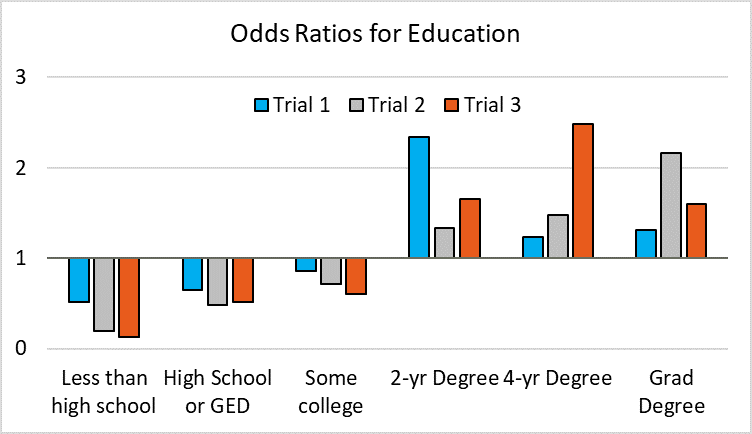Who shows up for jury duty?

A few months ago, my colleague Dennis Devine wrote about the bad rap jury service seems to have, and how so many folks want to get out of it. It got me thinking – are there trends in who even shows up for jury service?
The quick answer to that is, yes! Tons of evidence shows despite attempts to draw a representative cross-section of their jurisdictions, prospective jurors and juries tend to be less racially and ethnically diverse than the districts they are supposed to represent.[1] What about other demographics? Can we expect certain groups of people to show up more or less often than others?
Last year, ThemeVision reviewed thousands of prospective juror demographics while assisting with jury selections across the country. Here, I compare gender, age, and educational data from three large trials – totaling 1800 prospective jurors – to their jurisdictions’ Census data. I wanted to know if, like the data on race and ethnicity, certain individuals consistently showed up for jury service more or less than others in our trials. Here’s what we saw.
The charts below show odds ratios[2] comparing the proportion of each group in the population, according to Census data, and the proportion of each group in the jury pool. Odds ratios less than one (“1”) indicate the group was under-represented in the jury pool, and odds ratios greater than one indicate the group was over-represented.
Men and women showed up for jury service at similar rates. Across the three examined trials, gender distribution of the venire was not significantly different from the jurisdiction’s population; their odds ratios were very close to 1. The number of men and women we’d expect to show up based on Census data did show up. [3]

The venires were more highly educated than their jurisdictions. In all three trials, more people had Associates, Bachelors, and Graduate degrees than we would expect to see given the distribution of education in each jurisdictions’ population. In some cases, prospective jurors with college or graduate degrees were more than twice as likely to report for jury service than prospective jurors without those degrees.

Middle-aged individuals showed up at higher rates than older or younger individuals. In our trials, age skewed a bit older than what we’d expect based on Census data. Individuals aged 45-54 and 55-64 were slightly over-represented, but far fewer individuals over 75 showed up than expected based on population. This makes sense, considering many states allow individuals over 75 to be excused from service.

You can – and should – supplement these observations with insights from local counsel in the jurisdiction where your trial is taking place, or your own past experiences. We focused on three big trials, but show rates and characteristics may be different in different jurisdictions or among different sized jury pools.
But no matter what your venire looks like, there are some things you always can do when developing strategy for exercising strikes and speaking to jurors on your panel:
- Explore education type in addition to education level, and consider both in employment contexts. Does the prospective juror have training or job experience in fields related to the case? Might they bring to the table background knowledge that will help them understand the facts – and maybe even explain these facts to other jurors in a way that helps you and your client?
- Know which facts are on your side. Jurors don’t need to understand everything about the case. If you have a complex case, even the most educated jurors can struggle to comprehend complex facts and issues. Mock jury research can help identify which facts are most beneficial to your case and support your trial themes, so you know to emphasize those facts during trial.
- Tell a compelling story. Once you know which facts are on your side, you need to know how to convey them in an understandable way. Jurors pay attention and appreciate when attorneys have an organized presentation with helpful demonstratives – in fact, organization and storytelling is one of the most effective ways for attorneys to argue for their clients.[4] Be the trusted voice in the room – be the attorney the jury can see has prepared, is competent, and can help them understand potentially complex topic.
[1] See Whitewashing the Jury Box and Case of George Floyd protester reveals D.C. is missing Black jurors
[2] There are several ways to measure under-representation of groups in jury pools. For a discussion of methods, see Kadane’s recent article Odds ratios as a measure of disproportionate treatment: application to jury venires.
[3] Across these three trials, just one individual selected a non-binary gender option.
[4] What Juries Really Think: Practical Guidance for Trial Lawyers
Get ThemeVision on your team and get a clear, confident strategy for success.
let’s talk
